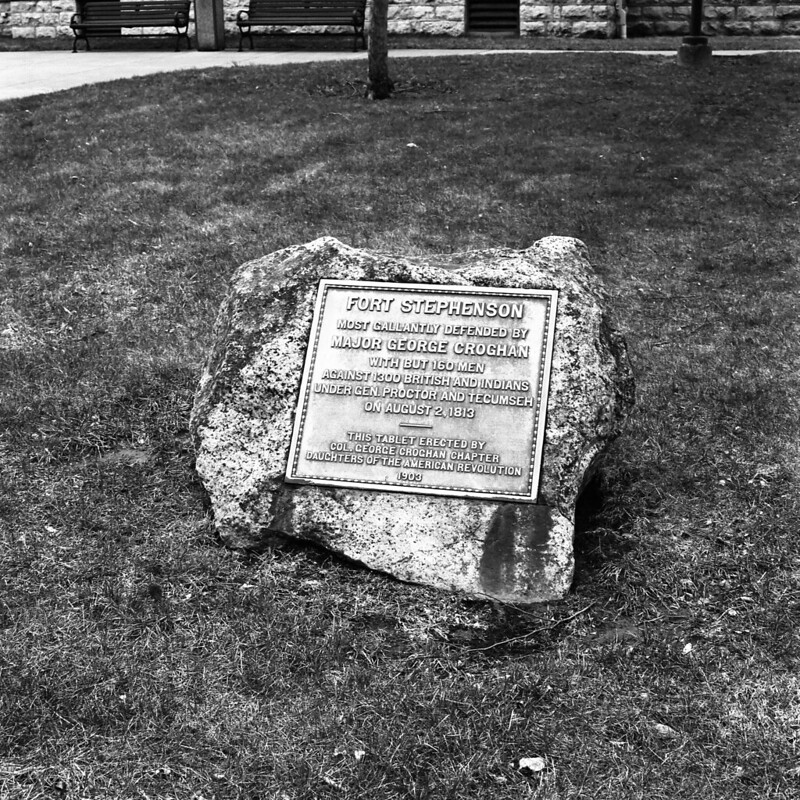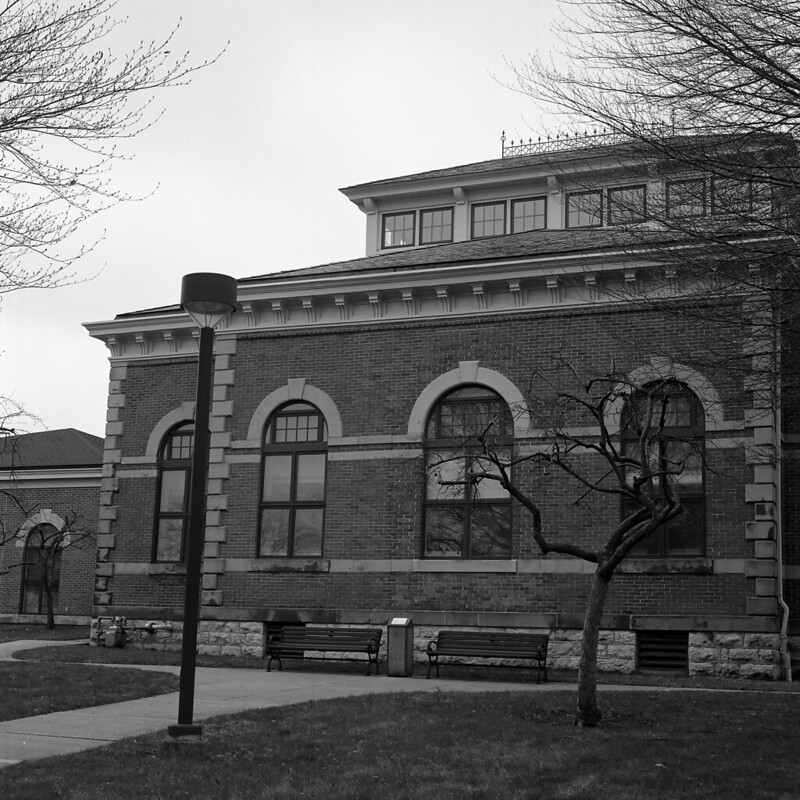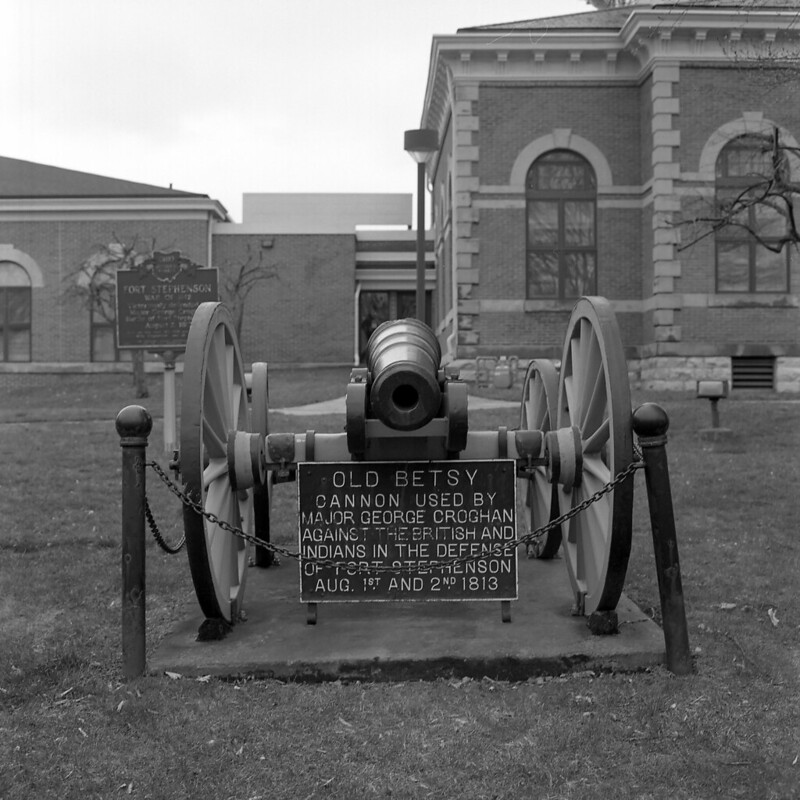Fort Stephenson was a sleepy supply depot fort built under the orders of General William Henry Harrison after he gained command of the Army of the Northwest in 1813. Fort Stephenson’s task was to guard the Sandusky River. The fort consisted of a palisade wall with three blockhouses. By the summer of 1813 was under the command of the young Major George Croghan, and a garrison of 160 regulars from the 17th and 24th US Infantry, along with the local militia.

Zenza Bronica SQ-Ai – Zenzanon-S 80mm 1:2.8 – Kodak Tri-X 400 @ ASA-400 – Kodak Xtol (Stock) 6:15 @ 20C
After the failure of the second British assault in early July of 1813 against Harrison’s largest supply forts, Fort Meigs Harrison knew that the great native leader Tecumseh was still spoiling for a fight and Harrison figured that he would target Fort Stephenson. So on July 29th a messenger was dispatched to Major Croghan to retreat across the river to headquarters and burn Fort Stephenson. However the messenger got lost and did not make it until late in the day of July 30th. Croghan, sent a reply stating that he would be unable to complete the task and stated that he and his garrison would stay and defend the fort. Harrison, furious that his direct order was disobeyed sent Colonel Wells to relieve Croghan of command and execute his original orders. Instead of accepting this Croghan went to Harrison personally to plead his case. Harrison impressed gave Croghan his command back, allowing him to stay and stand against the British attack which was sure to come.

Zenza Bronica SQ-Ai – Zenzanon-S 80mm 1:2.8 – Kodak Tri-X 400 @ ASA-400 – Kodak Xtol (Stock) 6:15 @ 20C
General Procter had marshaled a force of 1300 men from the 41st Regiment of Foot, Native Warriors and local militia, unable to take on the American Naval base at Presque Isle, had Commodore Barclay pin down the small squadron while his forces moved by gunboat towards Fort Stephenson. Major Croghan set about preparing his command for the attack, digging a seven foot deep, and nine foot wide ditch along the northwestern approach to the fort, believing that if the British attacked, that’s where they would attack from. Also bayonets and logs were fixed along the outer wall of the fort. By August 1st, 1813 Procter’s force had setup a small artillery battery and opened fire on the fort. After a day of shelling, the fort was approached by Colonel Elliot and Major Chambers under a flag of truce, Croghan sent Ensign ship, under a similar flag to meet the two British officers. The British citing their superior force and that if the fort were taken, they would be unable to control the native warriors, hoping that the mere idea of a massacre would scare the young American officer. Shipp however stated that if the British were able to take the fort there would be no one left the massacre, as they would fight as long as there were men still able to stand. After the officers returned to their respective camps, the British battery opened up on the fort again. The British would be forced to pay for the fort with their own blood.

Zenza Bronica SQ-Ai – Zenzanon-S 80mm 1:2.8 – Kodak Tri-X 400 @ ASA-400 – Kodak Xtol (Stock) 6:15 @ 20C
Croghan, had the fort’s single six-pound cannon fire on the British camp as well, moving it around the fort to make it seem that they had more than just the one gun. Despite the rain of over five hundred cannon balls the British sent onto the Fort it was not enough to break through the wall. Procter soon realized that the fort could only be taken by an infantry assault and split his force into two columns, while leaving the native warriors in the woods to ensure that if the Americans retreated they would be taken care of. Procter sent a small column toward the southwestern approach of the fort while the bulk of his forces attacked the northwestern approach, Procter hoped this ploy would have Croghan split his force allowing him an easier time to take out the small garrison force. Croghan however saw through Procter’s plan and kept a majority of his force on the northwestern side along with his six-pounder, now hidden inside the blockhouse. Colonel Short leading the main attack force managed to rally his troops despite being raked with rifle fire from the fort, lead the troops into the ditch, thinking it would give them cover. However it was exactly what Croghan wanted, the six-pounder had already been pre-sighted for the ditch, and let loose grape-shot, with nowhere to hide, or escape to, the British attack force was decimated, only a few managed to escape the carnage. Within half an hour of the assault starting it was over, the British quickly retreated and by nightfall escaped by the river back to Fort Amhurstburg. The British suffered 23 killed, including Colonel Short, 28 missing, and 35 wounded, the Americans had only one death, a 14 year old boy, and a hand full of wounded.

Nikon D300 – AF-S Nikkor 14-24mm 1:2.8G
The British never made another attempt at the Northwest, Oliver Hazard Perry’s Squadron made sure that the British hold on Lake Erie was smashed in September opening up the way for General Harrison’s Army of the Northwest to chase the British to Thamesville, defeating them and ensuring that the British would never field an army in the west for the rest of the war. Major Croghan was promoted by President Madison to Lieutenant Colonel and awarded the Congressional Gold Medal for his actions. Fort Stephenson is long gone, and the battlefield covered by the city of Freemont, OH. The grounds where the fort stood now is home to the Birchard Library. A plaque and monument stand on the property. Oddly enough, the small six-pound cannon, named “Old Betsey” also remains on the grounds as well. The city of Fremont celebrates Croghan Day every August in honour of the young officer, a national hero.
Written with files from:
Guidebook to the Historic Sites of the War of 1812 Second Edition by Gilbert Collins – 2006 The Dundurn Group Publishers
birchard.lib.oh.us/BFSBattle-of-Fort-Stephenson.htm
www.ohiohistorycentral.org/entry.php?rec=717
Photos:
Bronica SQ-Ai – Zenzanon-S 80mm 1:2.8 – Kodak Tri-X 400
Dev: Xtol (Stock) 6:15 @ 20C